Tanuki
The beloved trickster yokai of Japan
Today I am writing about tanuki, the beloved shape-shifting trickster from Japanese folklore. Entire books could be written about tanuki but in order to keep this article a manageable length, I will only be scratching the surface of tanuki lore. Despite that, hopefully I’ll give you a good overview of this fascinating yokai and the role it plays in in Japanese folklore and culture.
In this article I will be sharing:
what tanuki are and why they are so popular
where you are most likely to see tanuki if you visit Japan
some folktales featuring tanuki
a collection of ukiyo-e prints showcasing one of their more bizarre features
a film recommendation and some links for further reading.
In Japanese folklore, the tanuki is one of the most well-known yokai. For those who don’t know, yokai is a broad term that covers a myriad of supernatural creatures and phenomena. Tanuki are real animals too, and although the name is often translated as ‘racoon-dog’ they are actually from the canid family and are not related to racoons. Yokai tanuki are sometimes known as bake-danuki or changing tanuki, and are the supernatural form of these animals. They are believed to be shape-shifting tricksters with extremely impressive magical abilities. One of the most prevalent behaviours of the tanuki is a capacity to change form and disguise itself in order to trick humans. There are tales of tanuki taking the shape of Buddhist monks and also of beautiful women. In both cases the motivation is to deceive their unsuspecting victims, sometimes for fun but other times with far more sinister motives. In some cases they are able to create sophisticated illusions, including the ability to completely alter people’s perceptions of their environment. In Japanese folklore it is often suggested that if no explanation can be found for mysterious phenomena, it could simply be the work of a tanuki.
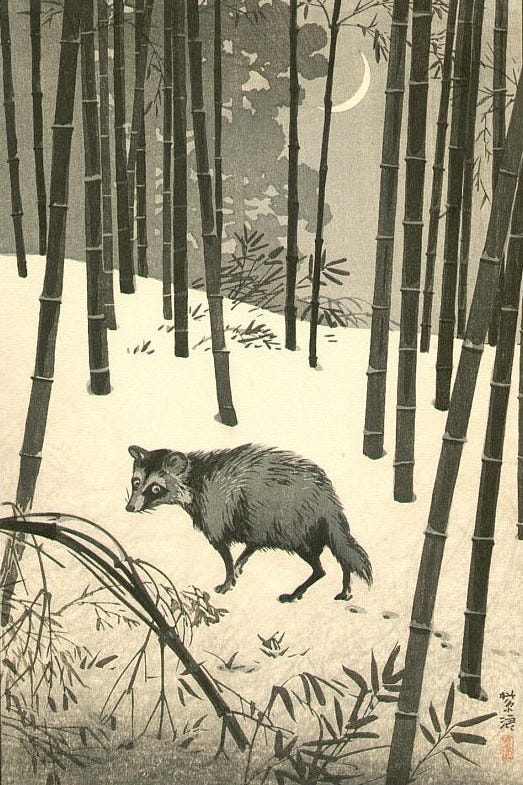
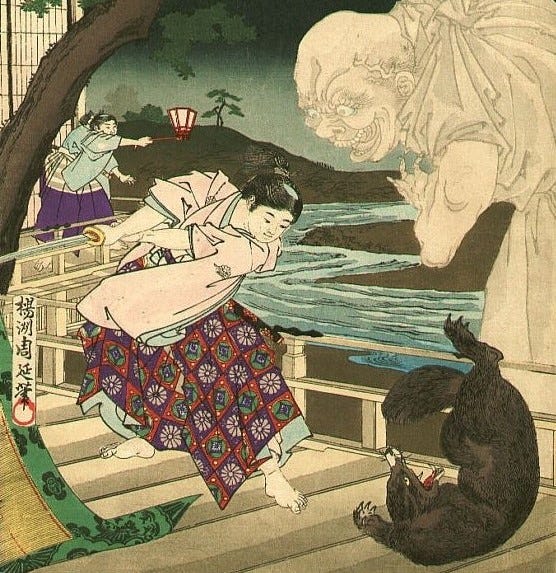
In the past tanuki were more commonly viewed as evil tricksters, however today in Japan you will often see statues of them outside shops and restaurants. These statues highlight one of their more unusual features which is their extremely large scrotums. Surprisingly this feature is actually connected to good luck regarding money and there are a few theories as to why this is the case. Apparently in the past metal workers used tanuki skin when hammering out gold. Because the skin was so strong, they were able to hammer the gold into extremely thin sheets. Another factor relates to language. In Japanese slang scrotums can be referred to as kinbukuru, which means money bags, while small balls of gold are known as kintama in Japanese. Because the phrases sound similar it followed that tanuki scrotums and gold were linked, and the tanuki’s expanding scrotums parallelled the ability to stretch or expand one’s gold or wealth. Today these statues are placed outside businesses with the hope of attracting wealth, prosperity and good fortune.
Here is a collection of tanuki statues that I photographed on my last trip. Do you have a favourite? If so, please leave me a comment, I’d love to hear which one it is.
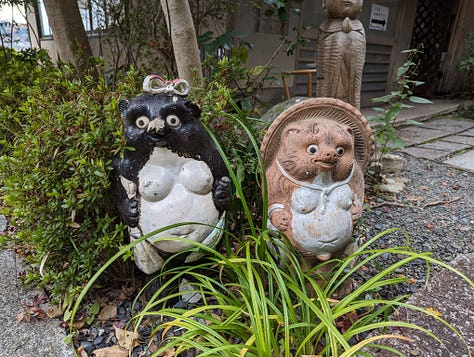
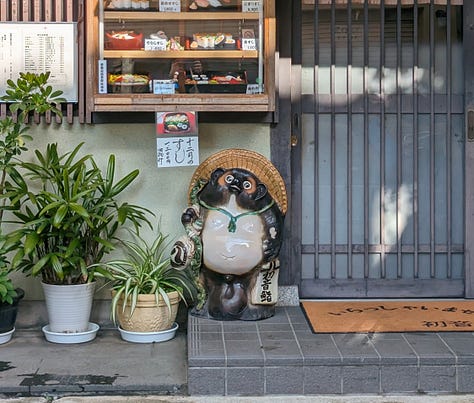
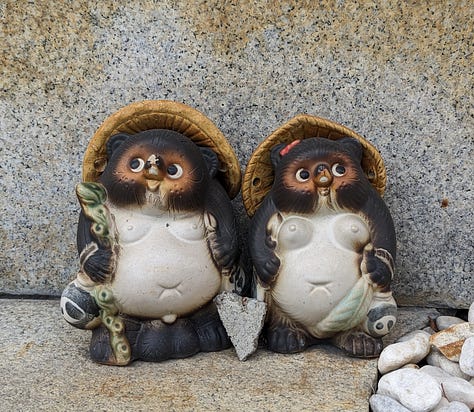

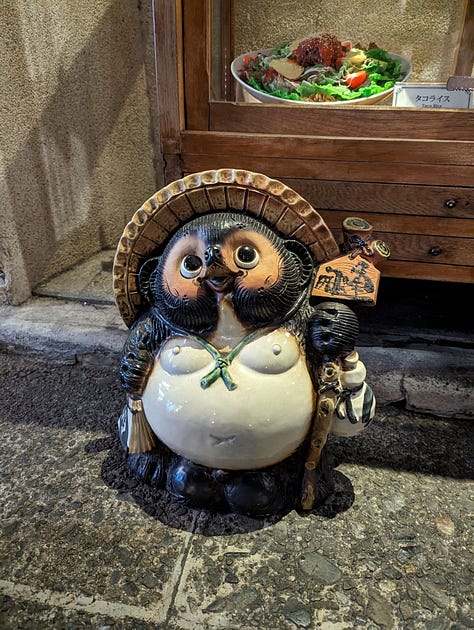


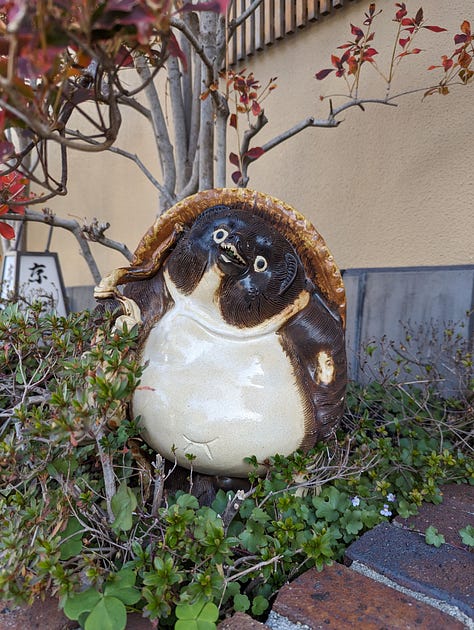
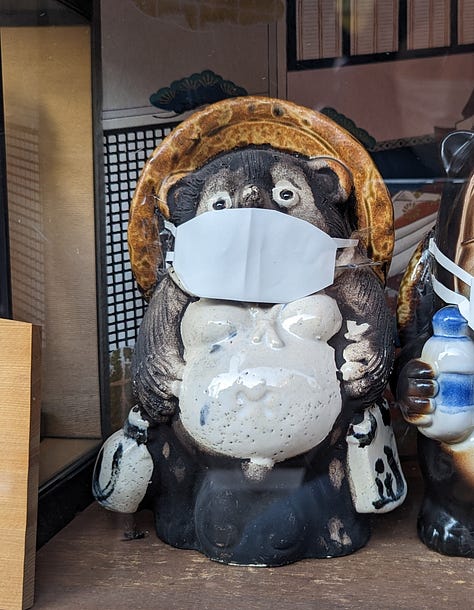
A Tanuki Shrine
While in Kyoto I also came across a tiny tanuki shrine tucked away in an alcove on Yanagikoji Street, a narrow winding thoroughfare in the Teramachi area near Nishiki Market. The shrine is called Hachibei Myojin and there isn’t much information about it that I could find in English. What I did discover is that apparently there used to be a temple in the area called Kankiko-ji which was home to three real tanuki, one of which was named Hachibei. In around 1888 the area was developed for shopping, theaters and business and many of the temples in the area were relocated to Teramachi Street, where some can still be found. The three tanuki from the grounds of Kankiko-ji were enshrined in three different locations as local guardian spirits. Hachibei Shrine is one of these. It seems the other two were absorbed into a hotel and a restaurant and I don’t know where they are now. I’m not sure who is responsible for maintaining this cute little shrine but apparently there is an offering box there during the day.
Tanuki in Folktales
Tanuki make regular appearances in Japanese folktales and one of the most famous is called ‘Bunbuku Chagama.’ It is about a tanuki that used its shapeshifting powers to transform into a kettle. This particular kettle was owned by a priest who had bought it from a local store. He discovered that it was bewitched when he put it on the hearth to boil and it sprouted the head, tail and legs of a tanuki. It would then run around madly before returning to its kettle form. The priest was keen to get rid of the kettle so he sold it a travelling merchant who soon discovered its secret. The tanuki assured the merchant that he meant no ill and offered to perform acrobatic tricks at a show in exchange for being treated well and not ever being put over a fire. The merchant agreed to this arrangement and over time he became very wealthy. Sadly, one day the tanuki informed him that he was near the end of his life and wouldn’t be able to perform any longer. After this the kettle never transformed again and the merchant donated it back to the temple with half his fortune. This tale is an example of a tanuki using its supernatural powers to be helpful, which isn’t always the case.
Another very well known tale is ‘The Farmer and the Tanuki’ also known as ‘Kachi-Kachi Yama’ which is often translated as Fire Crackle Mountain. In this tale a farmer was despairing because his fields were being destroyed by a tanuki. After many attempts he was able to finally catch the tanuki and string him up from the rafters in his home. He went out to work the next day instructing his wife not to release the tanuki under any circumstances as he planned to make him into soup that evening. The clever tanuki wailed and begged and cajoled and eventually the farmer’s wife felt so sorry for him that she untied him. He proceeded to kill her, shapeshift to take her form and then make her into a soup which he served to the farmer on his return. After eating his dinner, the farmer discovered the terrible truth by which time the tanuki had fled into the night.
A kind rabbit agreed to help the farmer get revenge. He befriended the tanuki and they set about collecting fire wood together, carrying it on their backs. The rabbit set the tanuki’s wood on fire, severely burning his back. He then offered to help by giving the tanuki a lotion made of chilli, which of course made matters even worse. While the taunki’s burns were healing the rabbit built two boats, one made of wood and the other made of clay. When he had recovered the tanuki accepted an invitation to go fishing. The rabbit gave the tanuki the clay boat which started to sink once they reached the middle of the lake. The tanuki called out for help from his ‘friend’ but the rabbit then told him he was avenging the murder of the farmer’s wife and pushed him under the water with his oar leaving him to drown in the lake. The farmer was so grateful that he let the rabbit live with him and they became good friends.
Tanuki in Ukiyo-e Art
Returning to the subject of the tanuki’s giant scrotums I’d like to share some rather unusual Japanese art. In the Edo period, ukiyo-e artist Utagawa Kuniyoshi created a series of prints depicting tanuki and their special talent for making use of their magical expanding scrotums. These humourous prints take the concept to extremes and you can see them being used for all sorts of inventive purposes. The print below shows tanuki fishing using a very unique kind of net.
The series of prints is quite extensive so I have included a gallery below with some of my favourites. They depict expanding scrotums being used for: transportation, shelter from the rain, a weapon to subdue a giant catfish, shop signage, props to enact the seven gods of fortune, a canopy over a fortune-telling booth, a weapon for hunting, weights for weight-lifting practice, and a sumo ring.

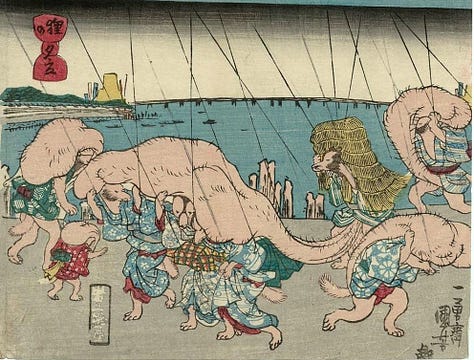
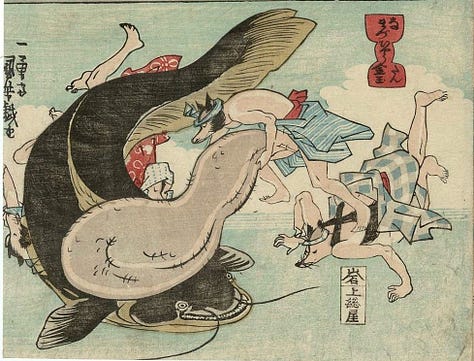

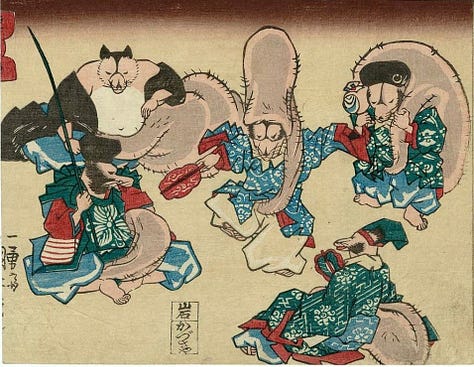
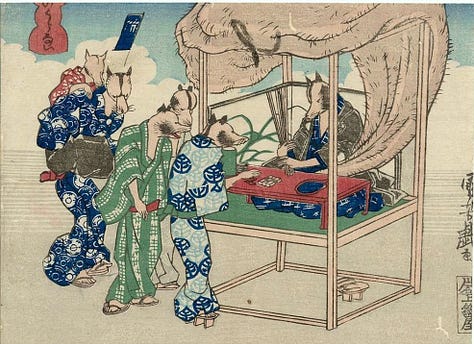

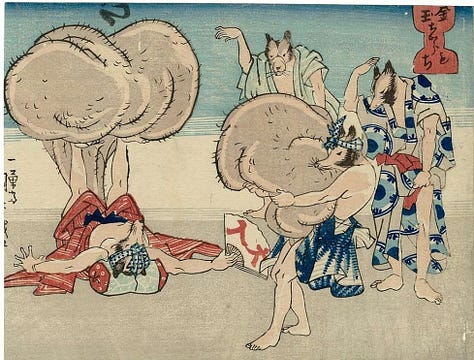

Tanuki on Film
If you have persevered this far I’d like to finally mention a Studio Ghibli film called Pom Poko. It's all about tanuki but plenty of other Japanese folklore features throughout, including a hyakki yagyo or demon night parade. The film showcases the tanuki’s amazing shapeshifting abilities as well as their magically expandable scrotums, which can be seen in the famous parachute scene. The Pom Poko of the title refers to the sound made by tanuki drumming on their bellies. The film’s narrative explores environmental themes as the tanuki battle against loss of habitat due to deforestation. If you enjoy Japanese anime or folklore, and want something a little different, I’d highly recommend Pom Poko.

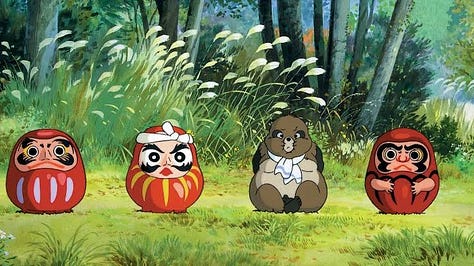



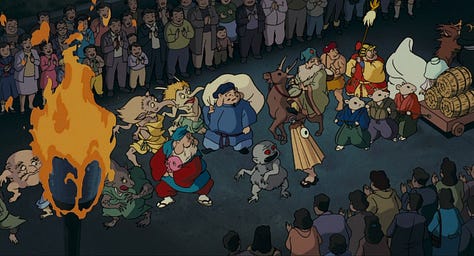
I hope you have enjoyed this introduction to tanuki. If you are exploring Japanese folklore or culture it would be hard to get far without stumbling across these intriguing creatures. When travelling in Japan you will see their statues everywhere and you may even see them in advertising. There are also references to tanuki in art, anime and computer games. While this article has ended up being another long one, it really is only the tip of the tanuki iceberg. If you are keen to learn more about tanuki I’ve included some links below.
Links for further reading
If you’d like to read another Japanese folktale featuring a tanuki that disguises itself as a monk, or either of the ones mentioned above in full, you can find them on my website here:
If you would like to do more serious tanuki research you will find this site probably has everything you need to get started, from history to iconography to folklore and more.
This newsletter is completely free and I do not offer paid subscriptions. If you enjoyed this article and would like to support my work, donations will be most gratefully received via Ko-fi.


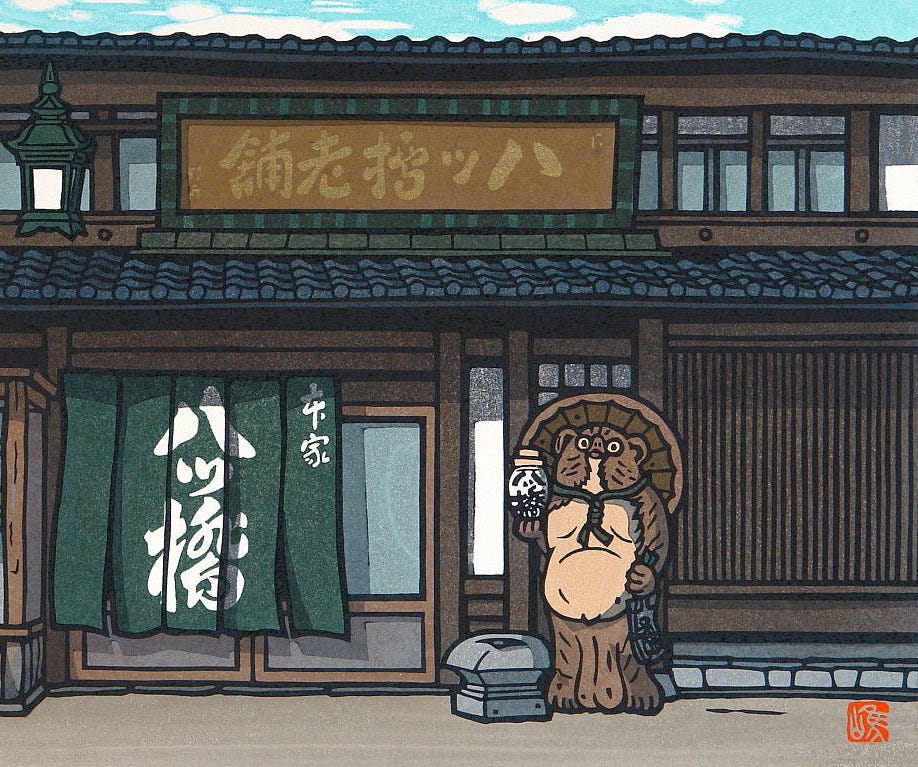

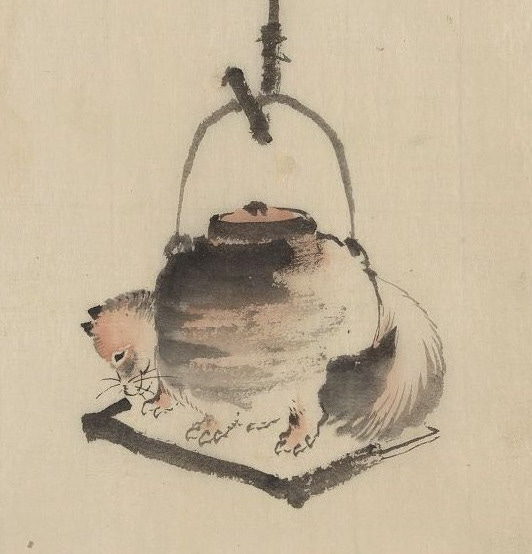
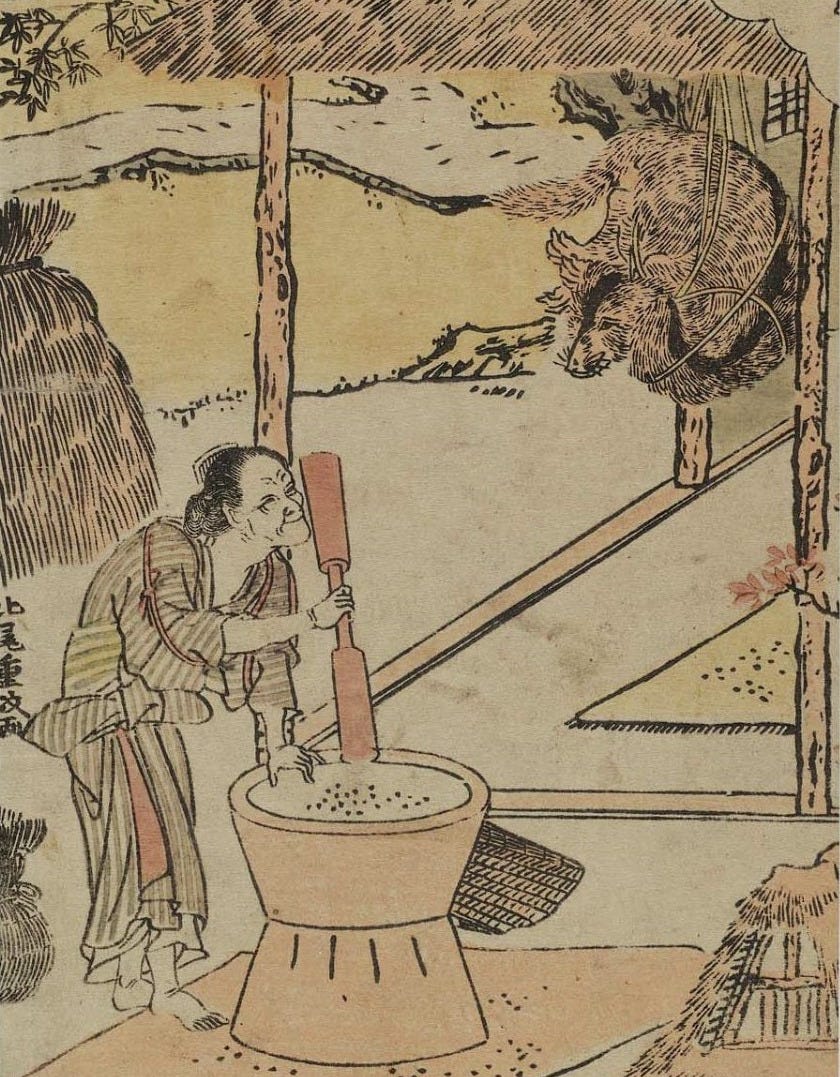
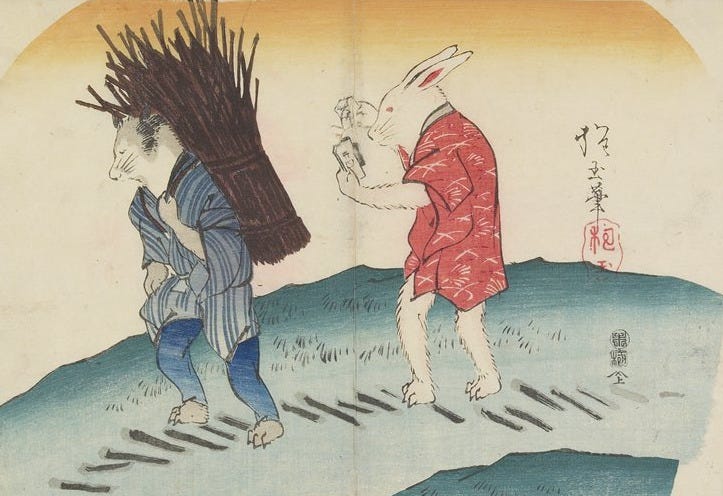

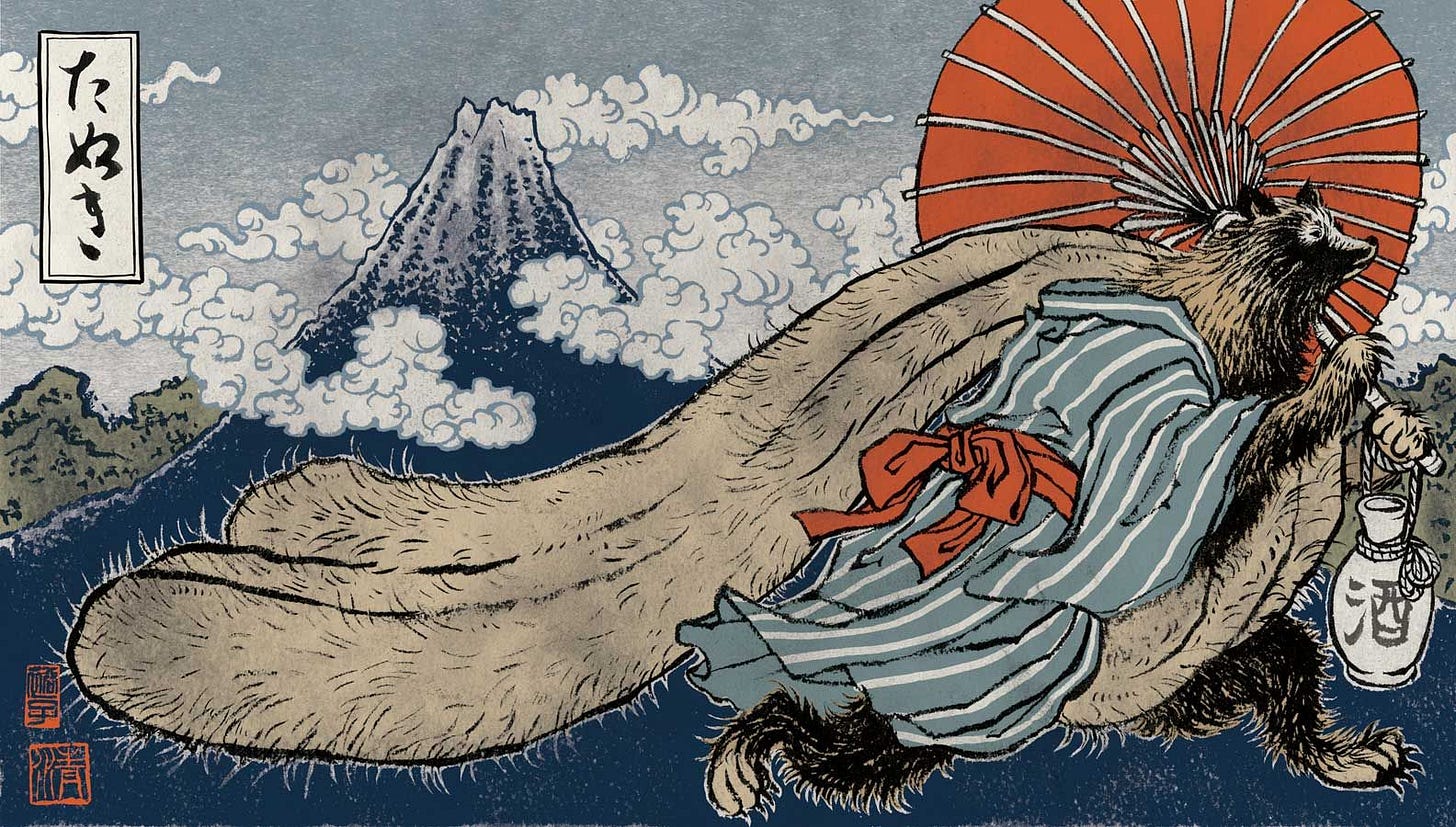

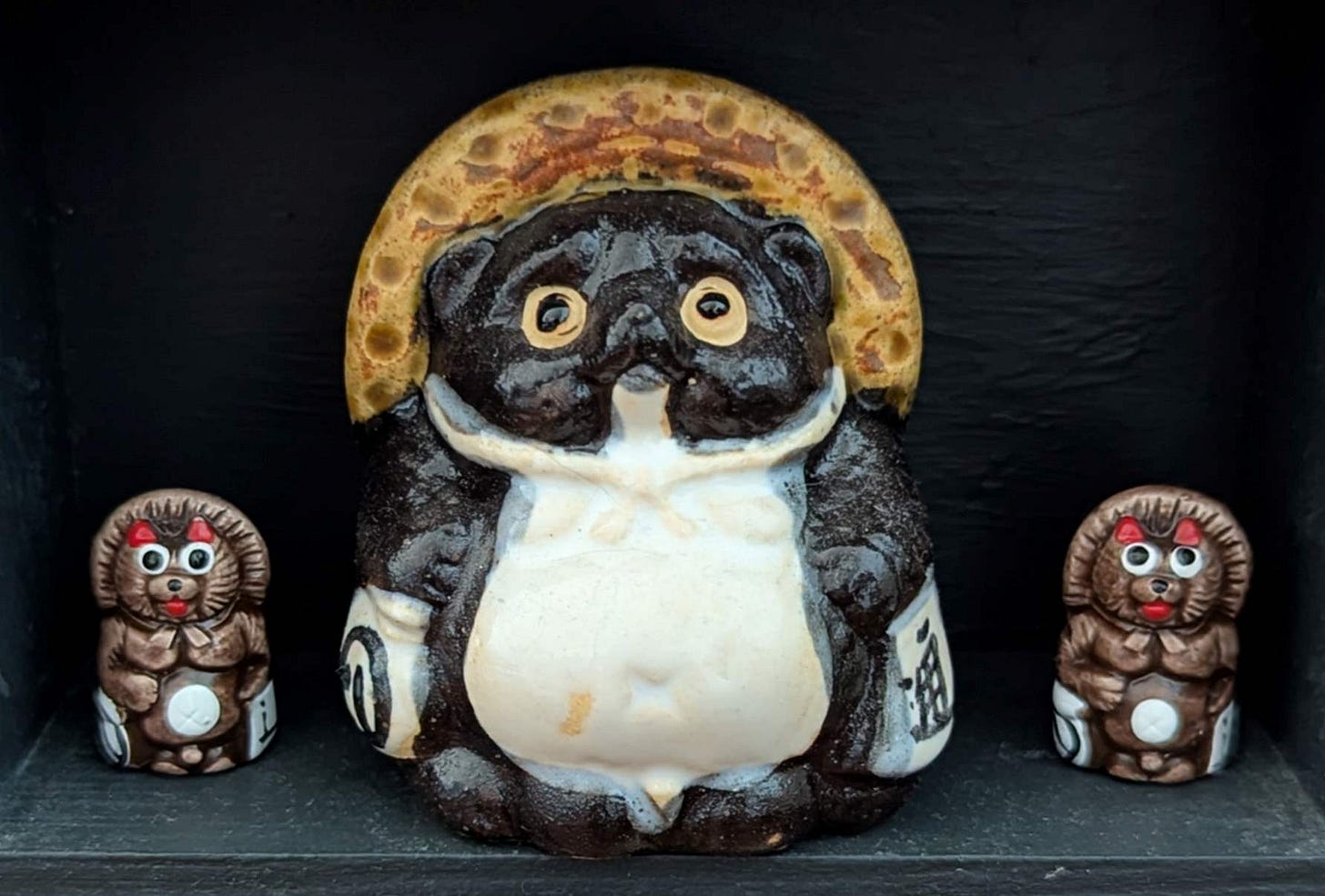
Such a great fun read! And absolutely loved Pom Poko
I love tanuki! Do you think people in Kansai display him more or less than in Kanto? I feel like I see him more in Kansai.